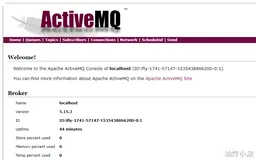ActiveMQ系列:结合Spring,基于配置文件的使用ActiveMQ
前面有介绍与基础部分,有兴趣的可以移步:
初步认识了ActiveMQ:https://blog.csdn.net/qq_26975307/article/details/98875098,
结合JavaSE进行初尝试:https://blog.csdn.net/qq_26975307/article/details/98968854,
详细讲讲JMS:https://blog.csdn.net/qq_26975307/article/details/99408962,
JMS的可靠性:https://phubing.blog.csdn.net/article/details/99412285
此篇开始结合Spring,基于配置文件的使用ActiveMQ
1、先了解下ActiveMQ的Broker
1.1、是什么
ActiveMQ的Broker(在Java中内嵌式的Broker,相当于一个ActiveMQ的实例)
Broker其实就是实现了用代码的形式启动ActiveMQ将MQ嵌入到Java代码中,以便随时用随时启动,在用的时候再去启动
这样能节省了资源,也保证了可靠性。
从activemq脚本可以看出启动ActiveMQ实际是启动,bin文件夹下的其实activemq.jar 包中有一个类为Main,这就是active的启动入口,Main主要是加载lib目录和ClassPath,初始化 类加载器,委托给ShellCommand,由ShellCommand根据命令描述去执行,如果是Version和HELP, 则打印信息,若是启动命令,则通过XBeanBrokerFactory创建BrokerService,这个过程主要利用的Spring的bean容器机制,然后启动BrokerService,主要启动持久化适配器,JMX连接,上下文关系器,最后启动所有网络连接,及TcpTransport连接TransportConnector,默认使用的是openwire:tcp,所以我们就看一下TcpTransportServer,TcpTransportServer有TcpTransportFactory创建并配置OpenWire协议转换器,启动TcpTransportServer,就是从ServerSocketFactory获取ServerSocket,并绑定ip和port,监听连接 ,并设置ServerSocket的监听器org.apache.activemq.transport.nio.SelectorManager.Listener,这个用的是java nio
1.2、嵌入式Broker
用ActiveMQ Broker作为独立的消息服务器来构建JAVA应用。
ActiveMQ也支持在vm中通信基于嵌入式的broker,能够无缝的集成其它java应用
顺带一提:
如果程序中出现:
Caused by: java. lang. ClassNotFoundException: com. fasterxml. jackson. databind. ObjectMapper
请引入以下 jar 包
<dependency> <groupId>com.fasterxml.jackson.core</groupId> <artifactId>jackson-databind</artifactId> <version>2.9.5</version> </dependency>
2、结合Spring,基于配置文件的使用ActiveMQ
2.1、配置 resources 文件
<?xml version="1.0" encoding="UTF-8"?> <beans xmlns="http://www.springframework.org/schema/beans" xmlns:xsi="http://www.w3.org/2001/XMLSchema-instance" xmlns:context="http://www.springframework.org/schema/context" xmlns:p="http://www.springframework.org/schema/p" xmlns:aop="http://www.springframework.org/schema/aop" xmlns:tx="http://www.springframework.org/schema/tx" xsi:schemaLocation="http://www.springframework.org/schema/beans http://www.springframework.org/schema/beans/spring-beans.xsd http://www.springframework.org/schema/context https://www.springframework.org/schema/context/spring-context.xsd http://www.springframework.org/schema/aop https://www.springframework.org/schema/context/spring-aop.xsd http://www.springframework.org/schema/tx https://www.springframework.org/schema/context/spring-tx.xsd"> <!--开启包的自动扫描--> <context:component-scan base-package="com.phubing"></context:component-scan> <!--配置生产者(也即获得Connection工厂)--> <bean id="jmsFactory" class="org.apache.activemq.pool.PooledConnectionFactory" destroy-method="stop"> <property name="connectionFactory"> <!--真正可以产生Connection的ConnectionFactory,由对应的JMS服务厂商提供--> <bean class="org.apache.activemq.ActiveMQConnectionFactory"> <property name="brokerURL" value="tcp://192.168.177.130:61616"></property> </bean> </property> <property name="maxConnections" value="100"></property> </bean> <!--这个是队列,点对点的(创建)--> <!--Spring经典的构造注入方式--> <bean id="destinationQueue" class="org.apache.activemq.command.ActiveMQQueue"> <constructor-arg index="0" value="spring-active-queue"></constructor-arg> </bean> <bean id="destinationTopic" class="org.apache.activemq.command.ActiveMQTopic"> <constructor-arg index="0" value="spring-active-topic"></constructor-arg> </bean> <!--Spring提供的JMS工具类他可以进行消息发送、接收等等--> <bean id="jmsTemplate" class="org.springframework.jms.core.JmsTemplate"> <!--告诉Template操作的是哪个链接,操作的是基于上述链接的队列还是主题--> <property name="connectionFactory" ref="jmsFactory"></property> <property name="defaultDestination" ref="destinationQueue"></property> <!--做了一些底层的强制转换与适配--> <property name="messageConverter"> <bean class="org.springframework.jms.support.converter.SimpleMessageConverter"></bean> </property> </bean> </beans>
在Spring中切换 Queue 与 Topic 非常简单,只需要把上述文件中的(destinationQueue)
<!--Spring提供的JMS工具类他可以进行消息发送、接收等等--> <bean id="jmsTemplate" class="org.springframework.jms.core.JmsTemplate"> <!--告诉Template操作的是哪个链接,操作的是基于上述链接的队列还是主题--> <property name="connectionFactory" ref="jmsFactory"></property> <property name="defaultDestination" ref="destinationQueue"></property> <!--做了一些底层的强制转换与适配--> <property name="messageConverter"> <bean class="org.springframework.jms.support.converter.SimpleMessageConverter"></bean> </property> </bean>
改为:
<!--Spring提供的JMS工具类他可以进行消息发送、接收等等--> <bean id="jmsTemplate" class="org.springframework.jms.core.JmsTemplate"> <!--告诉Template操作的是哪个链接,操作的是基于上述链接的队列还是主题--> <property name="connectionFactory" ref="jmsFactory"></property> <property name="defaultDestination" ref="destinationTopic"></property> <!--做了一些底层的强制转换与适配--> <property name="messageConverter"> <bean class="org.springframework.jms.support.converter.SimpleMessageConverter"></bean> </property> </bean>
即可
2.2、SpringMQ_Produce 消息生产者
package com.phubing.springmq_queue; import org.apache.xbean.spring.context.ClassPathXmlApplicationContext; import org.springframework.beans.factory.annotation.Autowired; import org.springframework.context.ApplicationContext; import org.springframework.jms.core.JmsTemplate; import org.springframework.jms.core.MessageCreator; import org.springframework.stereotype.Service; import javax.jms.JMSException; import javax.jms.Message; import javax.jms.Session; import javax.jms.TextMessage; /** * @ClassName SpringMQ_Produce * @Description TODO * @Author phubing * @Date 2019-08-06 22:30 * @Version 1.0 **/ @Service public class SpringMQ_Produce { @Autowired private JmsTemplate jmsTemplate; public static void main(String[] args) { ApplicationContext ctx = new ClassPathXmlApplicationContext("applicationContext.xml"); //只要通过xml注入的,默认首字母小写即可得到该bean(开启了包扫描并且加了@Service),相当于new SpringMQ_Produce produce = (SpringMQ_Produce) ctx.getBean("springMQ_Produce"); //使用Lambda表达式写法 produce.jmsTemplate.send((session) -> { TextMessage textMessage = session.createTextMessage("spring和ActiveMQ整合case,自动配置消费者"); return textMessage; }); System.out.println("发送成功"); /* 第二种写法 produce.jmsTemplate.send(new MessageCreator() { @Override public Message createMessage(Session session) throws JMSException { TextMessage textMessage = session.createTextMessage("spring和ActiveMQ整合case****"); return textMessage; } }); */ } }
2.3、SpringMQ_Consumer 消息消费者
package com.phubing.springmq_queue; import org.apache.xbean.spring.context.ClassPathXmlApplicationContext; import org.springframework.beans.factory.annotation.Autowired; import org.springframework.context.ApplicationContext; import org.springframework.jms.core.JmsTemplate; import org.springframework.stereotype.Service; /** * @ClassName SpringMQ_Produce * @Description TODO * @Author phubing * @Date 2019-08-06 22:30 * @Version 1.0 **/ @Service public class SpringMQ_Consumer { @Autowired private JmsTemplate jmsTemplate; public static void main(String[] args) { ApplicationContext ctx = new ClassPathXmlApplicationContext("applicationContext.xml"); //只要通过xml注入的,默认首字母小写即可得到该bean(开启了包扫描并且加了@Service),相当于new SpringMQ_Consumer consumer = (SpringMQ_Consumer) ctx.getBean("springMQ_Consumer"); String convert = (String) consumer.jmsTemplate.receiveAndConvert(); System.out.println("消费者收到的消息:"+convert); } }
3、使用 MessageListener 监听生产者,生产者启动,消费者也自行启动
3.1、application.xml 文件增加
增加 jmsContainer 的 DefaultMessageListener 需要实现 Messagelistener 接口的实现类
<bean id="myMessageListener" class="com.phubing.springmq_queue.MyMessagelistener"> </bean>
或者在实现 Messagelistener 接口的实现类上增加 @Component
package com.phubing.springmq_queue; import org.springframework.stereotype.Component; import javax.jms.Message; import javax.jms.MessageListener; import javax.jms.TextMessage; /** * @ClassName MyMessagelistener * @Description TODO * @Author phubing * @Date 2019-08-12 22:02 * @Version 1.0 * 让容器识别此类,有哪些方法? * 1、在Spring配置文件中配置bean进行注入 * * 假设又有别的类,岂不是越来越多配置到xml中? * 2、使用注解component(首先得开启包扫描) * * */ @Component public class MyMessagelistener implements MessageListener { @Override public void onMessage(Message message) { if(null != message && message instanceof TextMessage){ TextMessage textMessage = (TextMessage) message; try { System.out.println(textMessage.getText()); }catch (Exception e){ e.printStackTrace(); } }else{ } } }
启动生产者观察控制台情况
未完待续......(下篇结合Springboot,基于 application.yml 使用ActiveMQ)


